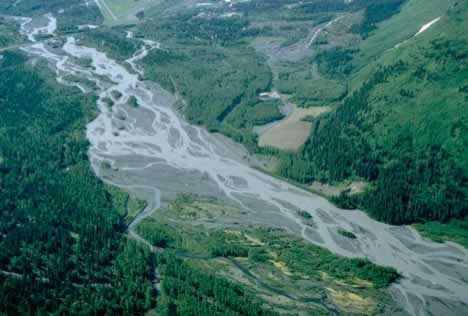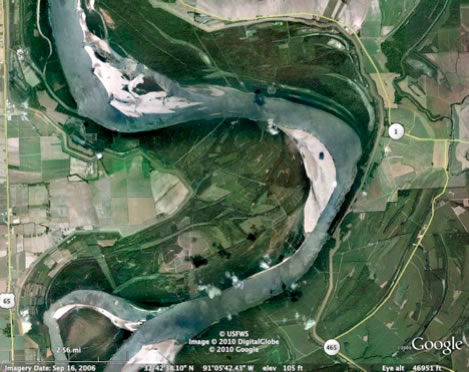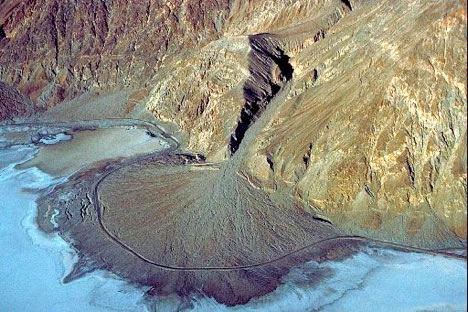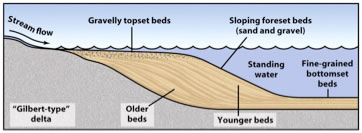Sedimentary Environments
Any area where sediment is capable of accumulating is considered a depositional environment. Each depositional environment posseses distinctive physical, chemical, and biological characteristics that allow for specific kinds of deposits. In this section we will look at how the properties of individual environments, found in continental, transitional, and marine settings, influence deposition and how this information is used to infer paleoenvironments.
Continental enviroments refers to all depostion that occurs on land; this includes fluvial systems (rivers and streams), lakes, deserts and areas adjacent to or covered by glaciers. At first glance it may seem impossible to be able to determine exactly which environment produced a given sediment but the factors that allow deposition behave extremely different in each environment.
 |
| Braided Stream, Alaska |
Fluvial environments are those environments that are dominated by runnin water and are characterized as either a meandering stream system or a braided stream system. Braided stream systems are typically found in areas with high slopes or in areas where the water contains a high sediment load. In either case, braided stream systems are characterized by fast moving water in multiple shallow channels that appear to be braided. These channels form when fast moving water dramatically slows and the larger particles (such as gravels) are deposited within the channel and block the flow of water. Because braided stream systems are high energy smaller clast sizes, such as silts and clays, are not deposited instead they are washed further down stream. As a result braided stream systems can be identified by their shallow channels of crossbedded-sands, gravel deposits, and the lack of mud or clays.
 |
| The Mississippi River, example of a meandering stream |
Unlike braided stream systems, meandering stream systems have a single stream channel and are found on gently sloped or flat areas. As a result of the gentle slopes water moves relatively slowly and is therefore only capable of carrying sediments no larger than sand. As the meandering stream moves across the land point bars develop on the inside curve of each turn. Point bars are depositional features that consist of crossbedded-sands and caused by the change in velocity of water as it moves through a curved channel. Meandering streams also develop large flood plains on either side of the stream channel. During flood stages excess water carrying suspended particles of silts and clays flows away from the fast-moving channel water. As a result this water is slowed and the finer particles deposited on the flood plain.
 |
| Alluvial Fan forming at the mouth of a canyon |
Because of their size desert environments are typically identified by the assoication of many geologic features, such as sand dunes (Large scale cross-bedded sands), alluvial fan deposits, and playa lake deposits. Alluvial fans form where streams and debris flows discharge from mountains onto a valley floor leaving a triagular, or wedge-shaped, deposit of sands and gravel; typically the larger clasts are more abundant closer to their sources. Beyond the alluvial fans wind flowing down the mountain slope is able to pick up previously deposited sands and redeposit them along the desert floor in sand dunes. Lastly, many deserts contain lakes formed from seasonal rains called playa lakes. Because the water contained within a lake is extremely still it is a low energy environment. During rainy seasons the water washing into the basin of the lake
will carry the sands, silts, and clays off the dry desert floor. As this water enters the newly formed lake the velocity of the water drops to nearly zero and throughout the dry season the finer particles of clay are capable of settling on the lake floor. Because this process occurrs every year playa lake deposits produce thin layers of mud, called varves, that record the seasonal deposition.
The sediment deposited in glacial environments is collectively known as drift. Glacial drift is deposited through a number of processes and is categorized as either till or outwash. Till is deposited directly by the melting ice along the glacial margin and consists of all sediment that has been picked up by the glacier as it scraped across the surface of the Earth. Unlike fluvial systems where the speed of the liquid water controls the maximum size particle that can be transported, glaciers have no limit to the size clast they are capable of transporting. Although they may move extremely slow-- maybe only a few inches a day-- any object that is incorporated into the icy structure is simply moved along with the ice and is eventually deposited in linear piles along the glacial margin. These linear piles of till are known as glacial moraines. Outwash deposits form as meltwater from the glacier deposits sands and silts in braided stream environments directly in front of the glacial margin.
Transitional environments are found anywhere both marine and land processes are responsible for deposition. These environments include beaches, deltas, barrier islands, and tidal flats. Deltas are accumulations of sediment that form when a stream enters a relatively quiet (low energy) body of water such as a bay, sea, or lake. Deltas get their name from the triangular shape (greek letter delta) that is often produced by this type of deposition. The true shape of a delta is controlled by both deposition and the rate of erosion. In areas where the rate of deposition is greater than erosion a delta will continually prograde into quieter body of water, such as the case with the Mississippi Delta. Where the rate of deposition is similar to the rate of erosion the delta will develop the stereotypical triangular shape like the Nile River Delta.
Regardless of the type of delta produced sand deposited within ancient deltas can be identified by the presence of foreset and bottomset beds. Foreset beds form when sediment laden fast moving water enter the low energy quiet water environment. When the velocity of the water drops the heavier sand sized particles are deposited at an incline along the floor of the open water body. Subsequent deposition occurs on top of the previously deposited foreset beds causing the shorline to prograde into the open water environment. Fine-grained material deposited transported by the river system is deposited away from shore in the lower energy environment and deposited nearly horizontal in what are know as bottomset beds.
 |
| Formation of a Gilbert-type delta |
Barrier islands lie offshore and are separated from the mainland by a lagoon or bay. On Long Island our barrier island is known as Fire Island and the lagoon is the Great South Bay. Barrier Islands are typically composed of sands which grade into finer deposits offshore. Cross-bedded dunes are also common features of barrier islands.
Marine Environments
Marine environments include the continental shelf, slope and rise, and the deep sea floor. Although much of the material eroded from the continents is eventually deposited within the marine environments other material such as those precipitated directly from the water are also deposited. The specific type of material that is deposited in a marine environment is determined by the environment's distance from shore, biological activity, and the depth of water.
The continental shelf is the gently sloping area directly adjacent to the continent and consists of both a high energy and a low energy environment. The high energy inner shelf is located closest to the shoreline; in this region sediment is constantly stirred up by wave action and tidal currents which produce large underwater cross-bedded dunes--called a hummocky terrain. Further from shore, in the lower energy outer shelf environment finer sediments, such as silts and clays, are deposited.
As sediment moves across the continental shelf it eventually comes to rest at the continental slope and rise. Within this region sediment is transported down the continental slope in turbidity currents-- a turbidity current is simply sediment laden current of water; on land this would be most similar to a mudflow. As a result of the constant deposition by turbidity currents graded bedding is common.
Beyond the continental shelf the sea floor is covered by pelagic clays. The energy of this environment is too low to transport larger particles such as sand and gravels from the continent. Instead the source of most detrital sediment is dust blown by wind off the continents or oceanic islands, this sediment is known as pelagic clay. Along with pelagic clay the calcareous (CaCO3) and Siliceous (SiO2) skeletal remains of microscopic organisms are also deposited in the form of oozes.
Limestone and dolostone are the most common carbonate rocks and we now know that dolostone is an altered form of limestone. In some respect the deposition of limestone is very similar to the deposition of detrital (clastic) sedimentary rock as it is often formed through the continuous deposition of sand-sized grains and microcrystalline carbonate muds. Because of this they may also contain sedimentary structures such as crossbedding and ripple marks. However, unlike clastic sedimentary rocks, carbonates are produced directly within their environment through chemical precipitation. During this process positively-charged calcium ions bond with negatively-charged carbonate ions to produce solid crystals of calcium carbonate (calcite) that precipitate out on the sea floor. This process requires relatively warm shallow water as calcium carbonate dissolves in cold-deep water.
